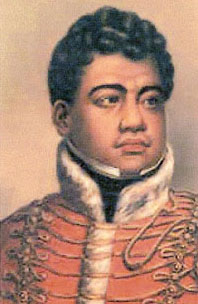- A Hilo au e lâ
- Ho`olulu ka lehua lâ
A Wailuku e lâ- I ka lua kanaka la
A Haili e lâ- I ke kula manu lâ
A Pana`ewa e lâ- I ka moku lehua lâ
A Lele`iwi e lâ- `Au`au i ke kai lâ
A Moloka`i e lâ- `Ike ala kâhi lâ
A Mauna Loa au lâ- I ka lua ko`i hala lâ
Ha`ina mai ka puana lâ- No ka lani nô he inoa lâ
He inoa nô Liholiho - Ho`olulu ka lehua lâ
- At Hilo
- I gather the lehua
At Wailuku- The man-destroying pit
At Haili- Is a plain inhabited by birds
At Panaewa- With its groves of lehua trees
At Lele`iwi- I swim in the sea
At Moloka'i- I see one road
At Mauna Loa- Is the adze quarry
Tell the refrain- In the name of the chief
- I gather the lehua
- The name-song for Liholiho
Source: - This pa`i umauma or chest slapping chant was composed for Liholiho who ruled the Hawaiian kingdom as Kamehameha II from 1819 to 1824. Verse 1 is in reference to Hilo, his birthplace, and his departure from Hilo to Kona. The lehua is symbolic of a young girl. Verse 2, the man-destroying hole is a cave for prisoners who committed misdemeanors. Verse 5, Lele`iwi heiau and the surrounding area was named after a despotic chief whose bones were desecrated by throwing them into the sea at this point of land, north of Hilo. The name immortalized this event. The heiau is where people were blessed and protected from harm in the water, for the sea had healing qualities for Hawaiians. Verse 6, Moloka`i is a reference to:1) a sea outside of the Hilo coastline and 2) an ancient path on Moloka`i. This is the poetic kaona for the chief travelling. Verse 7, Maunaloa is a place where adze makers gathered their stone called `alâ to make stone adzes, another poetic kaona reference. Told to M. Gay by Iolani Luahine and Edith Kanaka`ole. Edited by Dr. Barbara Price

Liholiho, Kamehameha II